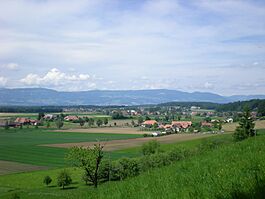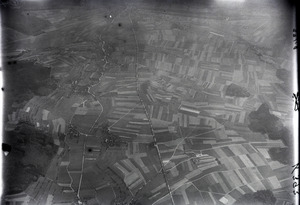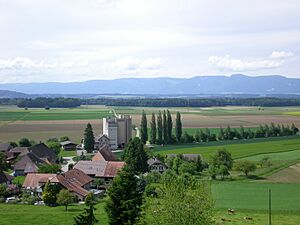Ersigen facts for kids
Quick facts for kids
Ersigen
|
||
|---|---|---|

Ersigen village seen from Rudswil
|
||
|
||
| Country | Switzerland | |
| Canton | Bern | |
| District | Emmental | |
| Area | ||
| • Total | 15.46 km2 (5.97 sq mi) | |
| Elevation | 500 m (1,600 ft) | |
| Population
(Dec 2020 )
|
||
| • Total | 2,063 | |
| • Density | 133.44/km2 (345.61/sq mi) | |
| Postal code |
3423
|
|
| Surrounded by | Kirchberg, Oberösch, Rumendingen, Utzenstorf, Wynigen | |
Ersigen is a town in Switzerland, located in the Emmental area of the Bern canton. On January 1, 2016, two smaller towns, Oberösch and Niederösch, joined with Ersigen.
Contents
Ersigen's Past: A Journey Through Time
People have lived in the Ersigen area for a very long time! We know this from old discoveries like tools from the Neolithic era (the New Stone Age). There's also an ancient burial mound from the Hallstatt culture and a Roman storage building.
The town was first mentioned in records in 1112, called Ergisingen. For about 300 years, from 1112 to 1418, a group of knights from Ersigen served powerful families like the Zähringen and Kyburg. These knights probably owned a lot of land in Ersigen.
In 1367, they sold their land to Peter von Thorberg. In 1375, the village might have been attacked by an army called the Gugler. A large graveyard found here is the only clue about this attack. Later, in 1397, Thorberg gave his land, woods, and the right to make minor legal decisions in Ersigen to the Thorberg monastery. Major legal decisions were handled by officials from Wangen.
By 1481, Ersigen had a small chapel connected to the main church in Kirchberg. This chapel was no longer used after 1528. In 1640, the village helped build and maintain the Emmen bridge and the main road between Bern and Zürich.
In 1803, Ersigen became part of the Burgdorf district. In 1824, a cheesemaker started a business in Ersigen. The town also received the Thorbergerwald forest from the canton in 1836.
During the 20th century, the villages of Oberösch and Niederösch became part of Ersigen. Ersigen was quite isolated until 1965, when the A1 motorway was built nearby. This made it much easier to get to Ersigen and led to new housing areas being built.
In the early 1900s, a place called Bad Rudswil in Ersigen was a famous place for medicinal baths. These baths closed later in the century. Today, most people in Ersigen work in farming or small industries.
Niederösch: A Village's Story
Niederösch was first mentioned in 886 as Osse. Later, in 1310, it was called villa Öschge inferioris. This village was once part of a larger village called Ösch, but it eventually became its own separate community.
The oldest sign of people living here is a grave from the late Bronze Age. In 886, the Abbey of St. Gall owned land in both Niederösch and Oberösch. This land was later given to Selz Abbey in Alsace in 994.
In the 13th and 14th centuries, the Kyburg counts also owned land here. They gave this land to their loyal followers. In 1320, Albrecht of Thorberg sold some land in Niederösch but kept the local forest and the right to handle minor legal cases. Later, he sold these to the Lords of Rohrmoos.
In 1423, Verena of Rohrmoos sold the minor court and forest to Burgdorf. Burgdorf then combined the courts of Niederösch, Oberösch, Rumendingen, and Bickigen. Niederösch has always been part of the Kirchberg church area. In 1803, it became part of the Burgdorf district.
Oberösch: Its Own Path
Oberösch was also first mentioned in 886 as Osse, and in 1310 as Oeschge superioris. Like Niederösch, it was originally part of the village of Ösch before becoming independent.
In 1423, Burgdorf gained half of the right to handle minor legal cases in Oberösch from Verena von Rohrmoos. Later, in the 16th century, Burgdorf bought the other half from the Thorberg Chapterhouse. They then combined these rights with the court of Niederösch.
Oberösch shared pastures with Ersigen and Rudswil (which is now part of Ersigen). In 1467, Burgdorf allowed the village to cut timber in the Reiteneggwald forest. This right was expanded in 1525 to include other forests. Oberösch has always belonged to the Kirchberg church area.
Farming has always been very important to Oberösch's economy. In 2005, most jobs in the town were in agriculture. However, many people travel to nearby towns for work. Oberösch and Niederösch share a school district, and the school is located in Niederösch.
Ersigen's Landscape: Exploring its Geography
Ersigen covers an area of about 8.8 square kilometers (3.4 square miles). A large part of this land, about 58.9%, is used for farming. Forests cover about 31.8% of the area. Buildings and roads make up about 9.5% of the land. A very small part, about 0.1%, is rivers or lakes, and another 0.1% is unproductive land.
Most of the forested land is covered with thick forests. For farming, about 48.5% is used for growing crops, and 8.9% is used for pastures. A small part, 1.5%, is used for orchards or vineyards. All the water in Ersigen is flowing water, like rivers or streams.
Ersigen is a linear village, meaning it stretches out along a line. It's divided into Oberdorf (upper village) and Unterdorf (lower village) along the Ösch stream. It also includes the area of Rudswil and scattered farmhouses.
At the end of 2009, Ersigen's old district, Amtsbezirk Burgdorf, was closed. On January 1, 2010, Ersigen joined the new Verwaltungskreis Emmental district.
Ersigen's Coat of Arms
The official coat of arms for Ersigen is described as: Or two Bends Gules. This means it's a gold shield with two red diagonal stripes.
Who Lives in Ersigen? Demographics
Ersigen has a population of about 1,880 people (as of 2023). In 2010, about 3.2% of the people living here were foreign nationals. Over the past 10 years (2000-2010), the population grew by about 8.1%. Most of this growth came from people moving into the town.
Most people in Ersigen (about 95.8%) speak German as their main language. Serbo-Croatian is the second most common language, and Albanian is third.
In 2008, about 50.5% of the population was male and 49.5% was female. Most residents are Swiss citizens. About 34.7% of the people living in Ersigen in 2000 were also born there.
Children and teenagers (ages 0–19) make up about 22% of the population. Adults (ages 20–64) make up about 60.3%, and seniors (over 64) make up about 17.7%.
In 2000, there were 590 single people and 767 married people in Ersigen. There were also 77 widows or widowers and 49 divorced individuals.
The chart below shows how Ersigen's population has changed over time:

Important Heritage Sites in Ersigen
The Gehöft house at Unterdorf 9, 10 is a very important heritage site in Switzerland. It's recognized for its national importance. Also, the entire village of Niederösch and the small group of houses called Oberösch are part of the Inventory of Swiss Heritage Sites. This means they are protected for their historical and cultural value.
Ersigen's Economy: How People Work
In 2011, Ersigen had a low unemployment rate of 1.47%. In 2008, there were 383 people working in the town.
- About 77 people worked in the primary economic sector, which includes farming. There were 29 businesses in this area.
- About 97 people worked in the secondary sector, which includes manufacturing and construction. There were 16 businesses here.
- About 209 people worked in the tertiary sector, which includes services like sales, transport, hotels, and healthcare. There were 43 businesses in this sector.
Many people who live in Ersigen travel to other towns for work. In 2000, 174 workers came into Ersigen, but 534 workers left to work elsewhere. This means more people leave Ersigen for work than come in. About 9.2% of working people used public transportation, and 55.4% used a private car to get to work.
Religion in Ersigen
Based on the 2000 census, most people in Ersigen (about 79.6%) belonged to the Swiss Reformed Church (a Protestant church). About 6.9% were Roman Catholic. A smaller number of people belonged to other Christian churches, or were Islamic or Hindu. About 3.71% of the population did not belong to any church.
Education in Ersigen
In Ersigen, about 41.2% of the population has finished upper secondary education (like high school). About 13.5% have gone on to higher education, such as university.
The Canton of Bern's school system starts with one year of optional Kindergarten. After that, students attend six years of Primary school. Then, there are three years of lower Secondary school, where students are grouped by their abilities. After lower Secondary, students can continue their education or start an apprenticeship (learning a trade on the job).
During the 2009-2010 school year, 170 students attended classes in Ersigen. There were 2 kindergarten classes with 37 students. The town had 6 primary classes with 108 students. There was also one lower secondary class with 25 students.
In 2000, 22 students came to Ersigen from other towns to go to school, while 170 Ersigen residents went to schools outside the town.
See also
 In Spanish: Ersigen para niños
In Spanish: Ersigen para niños







